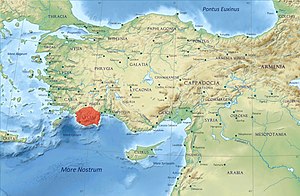Kherei (circa 433-410 BC,[2] or circa 410-390 BC) was dynast of Lycia, ruler of the area of Xanthos, at a time when this part of Anatolia was subject to the Persian, or Achaemenid, Empire.[2]
Kherei | |
|---|---|
 Portrait of Kherei, from his coinage. He wears the satrapal headdress, decorated with a laurel wreath.[1] | |
| Allegiance | Achaemenid Empire |
| Years of service | fl. 410 – 390 BC |
| Rank | Dynast of Lycia |

Present-day knowledge of Lycia in the period of classical antiquity comes mostly from archaeology, in which this region is unusually rich.[3] He may have been the dynast to whom was dedicated the Xanthian Obelisk, where he is mentioned in multiple places, although this could more probably be his predecessor Kheriga (Xeriga, Gergis in Greek).[4] Kherei may have been Kheriga's brother, and succeeded him.
Coinage
editKherei was among last the Lycian rulers to issue coinage. After 360 BC, the region of Lycia was taken over by the Carian dynast Mausolus.[5]
The portrait on the coins of Kherei show the dynast wearing the Achaemenid satrapal headdress.[6]
-
Coinage of Kherei. Circa 410-390 BC. Obv: Helmeted head of Athena. Rev: Head of Kherei, wearing Persian tiara decorated with laurel branch.
-
Coinage of Kherei. Circa 410-390 BC
Notes
edit- ^ CNG: DYNASTS of LYCIA. Kherei. Circa 410-390 BC. AR Stater (17.5mm, 8.53 g, 9h).
- ^ a b Anderson, John Kinloch (1970). Military Theory and Practice in the Age of Xenophon. University of California Press. p. 33. ISBN 9780520015647.
- ^ D. T. Potts, A Companion to the Archaeology of the Ancient Near East (2012), p. 912: "...c. 380–370 BC, two western Lycian dynasts named Arttumpara and Mithrapata claimed power simultaneously."
- ^ Keen, Antony G. (1998). Dynastic Lycia: A Political of History of the Lycians and Their Relations with Foreign Powers : C. 545-362 B.C. BRILL. p. 130. ISBN 9004109560.
- ^ CNG: DYNASTS of LYCIA. Mithrapata. Circa 390-370 BC. AR Stater (23mm, 9.73 g, 5h).
- ^ CNG: DYNASTS of LYCIA. Mithrapata. Circa 390-370 BC. AR Stater (23mm, 9.73 g, 5h).
Further reading
edit- Lotz, Helmut (2017). "Xerei, der Errichter des Inschriftenpfeilers von Xanthos". Kadmos (in German). 56 (1–2): 139–172. doi:10.1515/kadmos-2017-0007. S2CID 165480090.